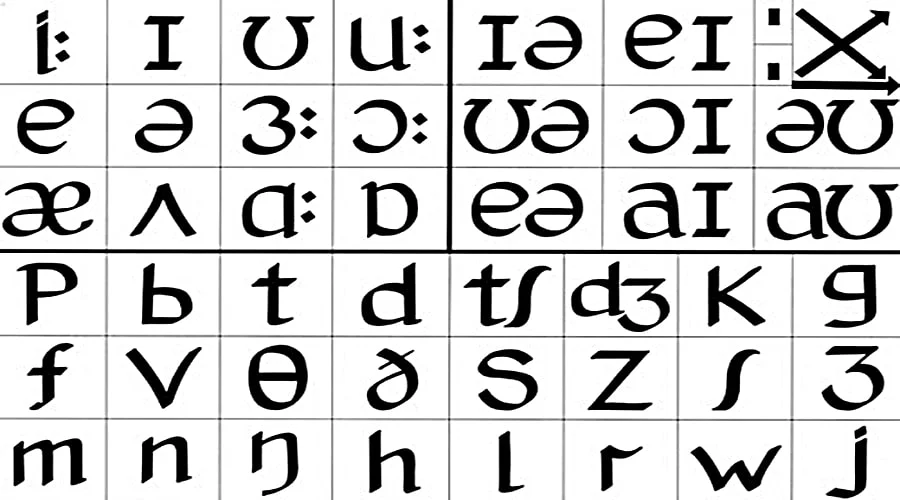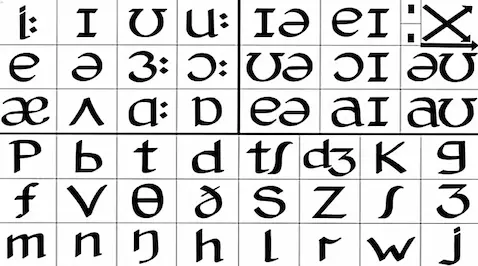This phonemic chart contains all of the 44 sounds, or phonemes, found in spoken English. It is divided into three sections:
- Vowels at the top left
Vowels are produced with the vocal tract open – air is not constricted or blocked at any point. - Diphthongs at the top right
Diphthongs are phonemes with two adjacent vowel sounds - Consonants at the bottom
When a consonant is produced a part of the vocal tract is closed, constricting or blocking the flow of air. Air can be blocked in a number of ways:- Plosive sounds are produced by blocking and then releasing air. Plosive sounds are /p/, /b/, /t/, /d/, /k/ and /g/.
- Fricative sounds are produced when air is obstructed by friction. Fricative sounds are /f/, /v/, /θ/, /ð/, /s/, /z/, /ʃ/, /ʒ/ and /h/.
- Affricate sounds are produced with a plosive followed by a fricative. /tʃ/ is a combination of the plosive /t/ followed by the fricative /ʃ/; /dʒ/ has a similar sequence of plosive and fricative.
- With nasal sounds, air has to come through the nasal cavity due to a blockage of air at another point in the vocal tract. /m/, /n/ and /ŋ/ are all nasal phonemes.
- There is one lateral phoneme, /l/, where air is blocked by the tongue from coming through the centre of the mouth and so has to come along the sides of the tongue.
- Finally, the liquid phonemes /w/, /r/ and /j/ are all “semi-vowels”, where air is diverted around the tongue rather than actually obstructed.
The grouping together of consonants, diphthongs and vowels is not the only logic to the organisation of the chart, however. The phonemes are also ordered according to the position of the mouth when producing them.
For the vowels, as you move from left to right along the chart (for example from /iː/ to /uː/), the tongue moves from the front of the mouth to the back, and the lips change progressively from flat to more “O”-shaped.
Similarly, as you move from the top of the vowel chart to the bottom (for example from /iː/ to /æ/) the lips also change from flat to “O”-shaped, and this time the tongue moves from the top to the bottom of the mouth.
With the consonants, sounds on the left are made at the front of the mouth, moving towards the back of the mouth by the time we reach the phonemes on the right.
| iː | ɪ | ʊ | uː | ɪə | eɪ | |
| beach | bin | could | moon | here | pain | |
| e | ə | ɜː | ɔː | ʊə | ɔɪ | əʊ |
| bend | about | fur | call | pure | boy | go |
| æ | ʌ | ɑː | ɒ | eə | aɪ | aʊ |
| band | cup | car | hot | there | my | now |
| p | b | t | d | tʃ | dʒ | k | g |
| pen | but | tin | do | chair | jump | cat | go |
| f | v | θ | ð | s | z | ʃ | ʒ |
| fun | very | thing | father | sun | zoo | she | casual |
| m | n | ŋ | h | l | r | w | j |
| mine | nine | song | hat | late | run | what | yes |
The symbols in the chart are taken from the International Phonetic Alphabet (IPA) which gives one letter, or symbol, for each phoneme. It can be very useful to integrate this chart and the pronunciation of individual phonemes into language learning from beginner level as a means of demonstrating and standardising the pronunciation of language items.
In English language teaching, when using the chart to show the pronunciation of a language item, we normally write the symbols between slashes. So, for example, the word “phonetic” would be written as /fənetɪk/.
You can download a phonemic chart here.








6 comments
Juniati Kala' Padang
Finally, I have found this phonetic chart after so long… I’m looking for more example words for each phoneme. Thank you so much!
Kelly
Thanku , after a long search for phonetic charts to help me study my online tefl course , I’ve finally found it on here and can move forward in my studying :)
Joanne
At last found an easy printable IPA chart!!
Bikila Dugasa
Best Of The Best
Mbengui Luzolo
I find it very helpful, and goes right with what I previously knew about the phonemes…
P8r
What about the voiceless bilabial approximant? (Wot? Yes, it’s a feature of standard spoken English). The voiceless palatal (or maybe palatalised velar) fricative at the beginning of “huge”? The dental stop in “aesthetic” or the bilabial fricative in “ophthalmic” or even, for some speakers, “diphthong”? Why omit standard English triphthongs such as in “fire”?
Etcetera.